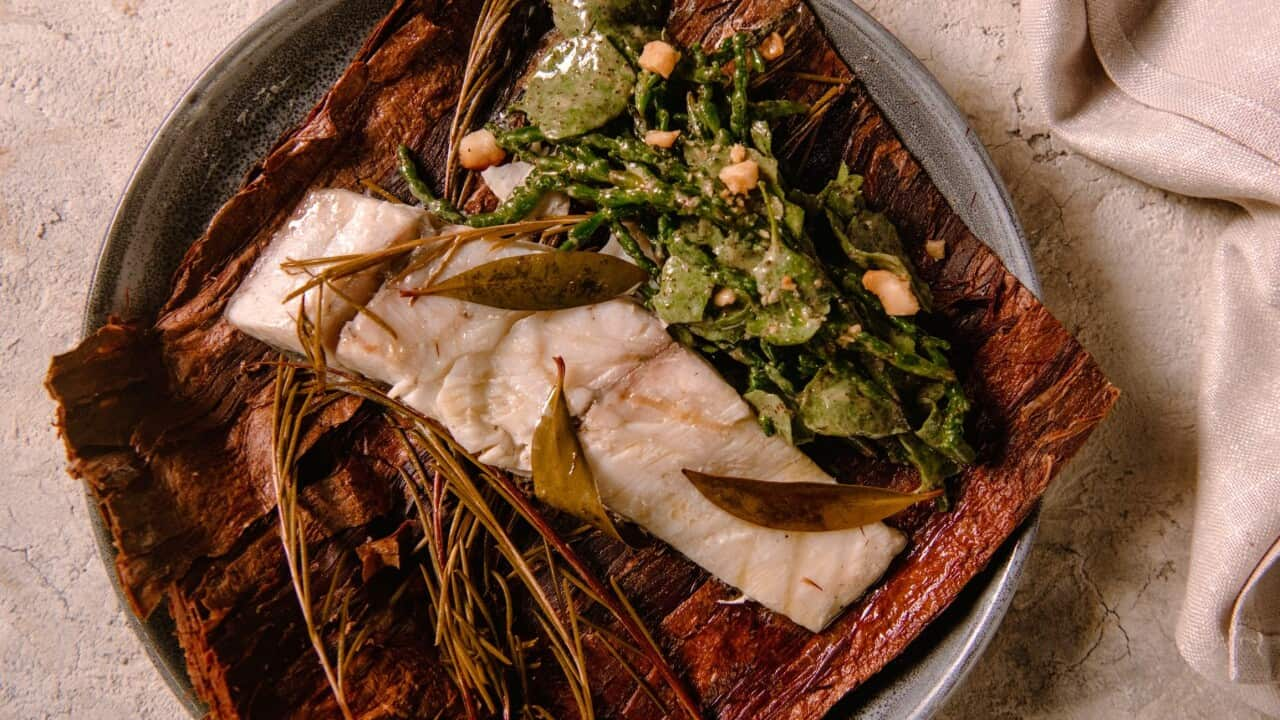serves
3-4
prep
10 minutes
cook
30 minutes
difficulty
Easy
serves
3-4
people
preparation
10
minutes
cooking
30
minutes
difficulty
Easy
level
Ingredients
- cooking-grade Paperbark and fresh lomandra fronds (see Note)
- several sprigs of fresh mountain pepper leaf and Geraldton wax
- 1 tsp pink salt flakes
- olive oil, for drizzling
- 2 skin-on, boneless barramundi fillets (180 g - 200 g each)
Salad
- 100 g samphire
- 100 g saltbush
- 100 g karkalla
- 45 g macadamias, crushed and roasted
Dressing
- 40 g dijon mustard
- 80 ml white wine vinegar
- 240 ml olive oil
- 5 lemon myrtle leaves, dried and ground
Instructions
- Soak the paperbark and lomandra fronds in cold water for a minimum of 30 minutes, then drain just before using.
- Place a piece (large enough to hold the fish fillets) of damp paperbark onto a baking tray, then top with half the fresh mountain pepper leaf and Geralton wax sprigs. Sprinkle with half the salt and drizzle with olive oil. Place the fish fillets on top, evenly spaced and add the remaining ingredients on top. Fold the paperbark to enclose the fish and tie with lomandra fronds to secure. You may need kitchen twine to enclose the fish completely.
- Preheat the oven to 180˚C fan-forced and bake for 20-30 minutes, or until the fish is cooked through – timing will depend on the paperbark and thickness of the fish.
- While the fish is cooking, make the dressing. In a large jug, whisk together the mustard and vinegar, then slowly pour in the olive oil until emulsified. Stir through the ground lemon myrtle leaves.
- Place all the salad ingredients in a large bowl. Just before serving, lightly toss the salad with the dressing. Serve the paperbark-baked barramundi with the salad.
Note
• Australian olive oil is recommended for use in this recipe. If you don't have access to paperbark, you can wrap the fish in foil and baking paper and secure with kitchen twine.
Photography by Jiwon Kim.
Want more from The Cook Up?
Cook's Notes
Oven temperatures are for conventional; if using fan-forced (convection), reduce the temperature by 20˚C. | We use Australian tablespoons and cups: 1 teaspoon equals 5 ml; 1 tablespoon equals 20 ml; 1 cup equals 250 ml. | All herbs are fresh (unless specified) and cups are lightly packed. | All vegetables are medium size and peeled, unless specified. | All eggs are 55-60 g, unless specified.










